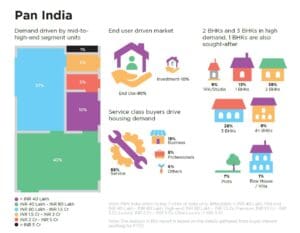The service class buyers in India is the dominant socio-economic segment and the primary homebuyer in this large nation. Post reforms and the pandemic, the markets have transitioned to be driven by end-users – prices remained range-bound, eliminating investors and speculators to a great extent.
A developing nation with rapid urbanization, rising nuclear families, and an increasing population are the most-suited ingredients for housing sector growth. ANAROCK Research delves into identifying the new trends among buyers and their preferences. The findings reveal evolving trends, which provide further insights to reinforce developer’s strategies in the future.
Key Findings:
- Mid-to-high-end segment units are the most preferred; accounted for 79% of the total demand
- Demand for 2 BHK units dominated the market with a 38% share, followed by 3 BHK units at 26%
- Service class buyers drive housing demand with a 68% share
- Business class and professionals accounted for nearly 26% of the total housing demand
- 90% of the Indian housing market is driven by end-users

Chennai and Pune showcased the highest demand in the mid-end segment and accounted for nearly 60% and 59% of the total demand in these cities. Bengaluru recorded almost 56% of demand geared towards the high-end segment. Of the city’ overall housing sales, Hyderabad displayed the highest demand for luxury (17%) and ultra-luxury (8%) segment homes priced above INR 2.5 Cr. While average prices in Hyderabad are much lower than in the Mumbai Metropolitan Region (MMR), property sizes in these segments are significantly larger than in MMR.
Across the major cities, the 2 and 3 BHK typologies yielded the maximum demand, accounting for 64% of the overall demand. 2 BHK units are most popular in Chennai, where nearly 67% of sales during the fiscal year were for this configuration. Bengaluru sold the most 3 BHK units, which accounted for 49% of overall sales during the year, closely followed by Hyderabad with 44%.
National Capital Region (NCR)
In Delhi-NCR, 4BHK+ and plots stole the show. The preference for independent and low-density living resulted in 4BHK accounting for 17% of sales, and plots accounting for 16% during the fiscal year. The region also witnessed 16% of the overall demand in 1RK/Studio category homes at the other end of the spectrum. End-user buyers accounted for 93% of transactions, with two-thirds hailing from the service class.
Mumbai Metropolitan Region (MMR)
Due to MMR’s urban sprawl and hectic market activities in peripheral locations, the demand for mid-range and high-end homes dominates. Mid-range housing accounted for 46% of overall demand during FY21-22, while high-end homes accounted for 39%. The preference for 2BHK units is rising, accounting for 50% of the demand. The prospect of future price appreciation is also attracting investors, with approx. 13% of buyers clearly stating that they are investing for the long-term.
On studying the buyers profile, it emerges that 64% are from the service class, and 23% are from the business communities. This diversity indicates a healthy mix that will help the market withstand economic disruptions.
Bengaluru
The Tech Halli also saw increasing interest from investors during the last fiscal. Nearly 16% of home purchases were by people focused on long-term investment. A significant part of this demand appears to be fuelled by an appetite for second homes in the city’s peripheral locations. While the final verdict on the future of workplaces is yet to emerge, a hybrid model is likely to be more popular, especially among employees of the IT-ITeS sector.
Socially distanced living in the peripheral regions to ensure better pandemic safety protocols has also increased demand for plots and villas. These assets accounted for approx. 12% of transactions. This group of buyers experienced minimal or no professional impact from the pandemic and had accrued significant savings due to limited scope for general consumption.
Despite the recent marginal hike, interest rates are still attractively low, while ongoing government incentives still work well for first-time end-user buyers and second home investors. As prices begin to rise and the mortgage rate hardens, the current market dynamics may change.

8 Comments